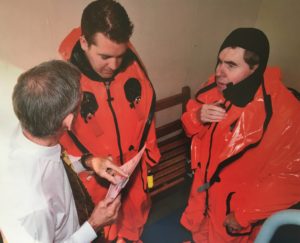Colin Clarke – What is sonar and how it works
Simon: So, for people that don’t know, can you explain what the Sonar side does on a submarine?
In effect, a lot of people would say it’s like underwater radar, so what it’s really doing is it’s just listening all the time for noise in the Ocean, and it’s able to give you a bearing of where it’s coming from and as Operators, you’re listening to those noises and you get trained to understand what ships sound like, submarines are like. What ice noise is , what fish sound like, what whales sound like. So, what Chesil Beach sounds like, so Chesil Beach in Portland, if you are off it, the waves rushing up and down all that shingle, you can hear that on a sonar and you can know exactly what it is.
Simon: And what you hear, is it the sound of the pebbles or is an electronic version of that or …?
No, you’re just listening to the actual sound that’s in the Ocean, and the system is just receiving it. It’s just a hydrophone that’s just listening all the time.
Simon: So, a hydrophone is an underwater microphone is it?
Yeah.
Simon: And those are … you have an array of those or …?
Yes, so there will be a number of different sonar arrays that would do different tasks. Some would be for long-range listening and be for shorter=range listening.
Simon: That’s down to the sensitivity of the microphone is it in some way? Long and short distance.
Well, they are designed for specific roles, so the short-range stuff tends to work at the higher frequencies as well. It’s all to do with the wavelengths, and then the long-range stuff works at the lower frequencies, so that’s listening for the sound that’s travelling … likely to travel the furthest in effect but it will be at the lower frequency.
Simon: Would that be an engine blade, a propeller, sorry.
Yeah, so you will be able to discriminate between the engines, the shafts, the blades. Sometimes you can even hear turbines wind up on the back of a ship, depending upon the quality of your sensor and where you are within the water column.







